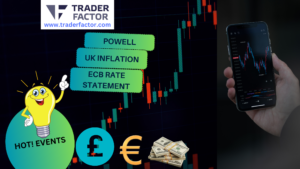Bitcoin just experienced an unprecedented surge, climbing 18% and pushing it back towards the all-time high of $25000.

After a weekend full of uncertainty in crypto markets due to USDC temporarily being unable to maintain its worth, recent events have clearly shown that digital currencies are still very much alive with potential for further growth; something seen especially evident by how they’re emerging as unlikely winners amidst SVB’s collapse.
Bitcoin took off on a wild ride today, rocketing 18% higher and pushing its gains to 25%, all thanks to the US Treasury announcing that the fed would act as an ultimate safety net for bank deposits.
The news gave cryptocurrency investors some much-needed assurance in uncertain times – good timing for bitcoin!
With the recent collapse of SVB and Signature bank, no one expected a rally in cryptocurrencies. However, despite the decline of USDC on Saturday due to news about SVB circulating through the crypto market, it rebounded Monday by regaining its peg against USD.
This volatility sparked a flurry of discussion among people online regarding stability within stablecoins which was answered when Changpeng Zhao declared Binance’s conversion from USD-backed coins into Bitcoin, Etherium and their own BNB coin proving some safety still remains for users around currency storage.

Is This A Moment Of Triumph For The Crypto Market?
On Monday, the collapse of SVB bank and Signature Bank served as a stark reminder that our traditional banking system is flawed.
With over $460 million in bitcoin positions and cryptocurrency liquidation, some are seeing this moment of triumph as an opportunity to promote self-custody through hardware wallets pushing us further away from physical cash reserves which have become increasingly frowned upon. Crypto’s popularity may probably be on the rise again!
Despite the challenges that have threatened to derail crypto’s progress, recent developments appear to be a renewed source of hope for Bitcoin traders.
The ongoing scrutiny and significant dips in market value last year haven’t dampened their enthusiasm or hindered adoption of self-custody practices rather it appears they’ve been buoyed by these events! It remains to be seen what will come next but optimism runs high amongst Crypto investors.
BTC Technical Outlook
Bitcoin unveiled an impressive rally last week when it broke above the $19700 handle, supported by a golden cross earlier in the week. The bullish performance takes on more significance given current macroeconomic conditions and could be seen as a delayed reaction to global trends.
Crypto and Bitcoin have broken two major resistance levels, leaving the psychological $25000 handle as their next challenge.
Should they be successful in conquering it, this could trigger an incredible rally to a potential retest of the resistance at $28000 followed by a surge towards an all-time high of over $30000!
Alternatively if there is rejection these precious gains may not come easily with traders needing to once again break through both previously conquered resistances around 23750 & 22500 respectively for continued success on their journey upwards.
Either way what lies ahead looks set to deliver plenty more volatility. So investors are likely to buckle up for one heck of a rollercoaster ride!
Wall Street Reaction After SVB Collapse
On Monday, the stock market saw a divergence in performance which can be attributed to investors pricing in an expected monetary policy shift from the Federal Reserve.
While Dow Jones suffered losses, Nasdaq 100 surged higher indicating that despite some short-term turbulence due to SVB fallout, markets are still optimistic of long term prospects and not yet foreseeing recessionary headwinds ahead.
However Asia Pacific stocks remain sensitive towards news updates on inflation levels given recent volatility seen across regional exchanges.
Charles Schwab was hit especially hard despite execs ensuring there was no connection between them and the now defunct Silicon Valley Bank or Signature bank that had recently gone under.
The tumultuous day caused investors across the financial sector to grapple with uncertainty about what may come next.
Investors around the globe remained on edge with market volatility continuing. The Dow Jones dipped 0.28%, but tech stocks surged forward – highlighted by a 1% jump in the FAANG Index (Facebook, Amazon Apple Inc., Netflix and Google).
This comes as US officials take action to boost financial security following last week’s collapse of Silicon Valley Bank (SVB), such as fully reimbursing depositors from SVB and Signature Banks plus introducing loans at the Federal Reserve based upon pledges for Treasuries or mortgage-backed securities.
Regional banks faced a harsh reality as investors fiercely drove down their share prices; Western Alliance and First Republic plummeted by 47% and 62%, respectively.
In stark contrast to this financial turmoil, Treasury bonds experienced strong buying activity on the same day due to worldwide fears of economic downturn causing the 2-year bond yield to experience its sharpest ever decline in anticipation of interest rate cuts from the Federal Reserve.
The US Dollar suffered and gold reaped benefits in response to a perceived Fed rate cut. This reaction was strikingly inverse from that of 2008 recession indications; contrarily, Bitcoin surged on this news.
As traders begin navigating increasingly uncertain terrain amidst rising yield spreads (54% increase reported), they should remain wary given historical precedents – with similar patterns experienced leading up to the last economic downturn in Q3 of 2008.
As Tuesday’s Asia-Pacific trading session approaches, the potential for volatility is simmering beneath regional indices.
While stocks may receive a boost from the Fed pivot in some sectors, investors should be aware of an upcoming US inflation report (CPI) that could potentially add another layer of market instability within just one day’s time.
Dow Jones
The Dow Jones has been confined within a steadily declining channel since the end of last year. After testing both its floor and key support level, an upward push could lead to trading above the 50-day SMA though this is by no means certain, as breaking lower suggests intensifying bearish momentum in the near future.
Nasdaq 100
The Nasdaq 100 has been trading within a Descending Channel, with the 50-day SMA acting as support for prices since early this month.
Prices tested but held above the floor of the channel however, if they fail to turn higher and break through resistance at its ceiling then losses could extend down to 11717 which is around 61.8% from current levels.
FTSE 100
Despite a few exceptions, most equity benchmarks have been unable to stave off the contagion which began in banking and has now spread more broadly.
As two of Britain’s biggest banks Standard Chartered and Barclays saw drops of over 6% each at one point, investors can be forgiven for being concerned about the FTSE whose substantial 17% weighting in financial stocks could make it particularly vulnerable if things don’t improve soon.
After a huge 4.2% drop, the FTSE continues to struggle as it moves past significant support levels with ease. Its next hurdle could be at 7513 or 7167 both of which mark previous highs and lows respectively.
However its ‘oversold’ status is not providing much confidence in these turbulent times. Resistance lies on the other side at 7617 and 7680 should an upward move come through soon enough.
DAX
Investors were feeling bearish on the DAX this week, leading to a sharp drop in value. Despite expectations of an ECB rate hike later this week-whether 25 or 50 basis points-it may not be enough to save Commerzbank and Deutsche Bank from steep losses.
Both are down significantly from their original values; 12.09% for former and 4.31 % for latter at time of writing .
With jitters over Silicon Valley Bank’s collapse still fresh, it remains unclear if even hawkish monetary policy will help restore investor confidence in European banks anytime soon.
German trading had been relatively successful, but today marked a sharp break in that trend with a 2.6% plunge below levels of support and toward the 15,000 mark psychologically.
There is still more room for selling to occur as current momentum remains bearish and RSI has yet to reach oversold territory.
Expected Events This Week
This week is primed to bring some serious turbulence in UK and EU banking stocks, so keep an eye out. Tomorrow we have the chance to evaluate just how influential last year’s surge of high earnings was on our economy – a situation that has caught the central bank’s attention for good reason.
Wednesday will offer insight into where those public funds are going it looks like our government is planning more thrifty measures as part of their plan to sort debt over half-a-decade!
Thursday will prove to be a pivotal day for the European Central Bank as they decide whether interest rates should rise by 25 or 50 basis points.
Instead of an increase four times greater than initially expected, market indicators are now pointing towards more moderate action all due to recent financial turbulence instigated in part by SVB’s failure. This sudden change serves as a reminder that conditions can shift quickly and drastically, thus impacting risk management strategies around the world.
Get More Updates From The Economic Calendar

Disclaimer:
All information has been prepared by TraderFactor or partners. The information does not contain a record of TraderFactor or partner’s prices or an offer of or solicitation for a transaction in any financial instrument. No representation or warranty is given as to the accuracy or completeness of this information. Any material provided does not have regard to the specific investment objective and financial situation of any person who may read it. Past performance is not a reliable indicator of future performance.
Author
-

Phyllis Wangui is a Financial Analyst and News Editor with qualifications in accounting and economics. She has over 20 years of banking and accounting experience, during which she has gained extensive knowledge of the forex, stock news, stock market, forex analysis, cryptos and foreign exchange industries. Phyllis is an avid commentator on these topics and loves to share her insights with others through financial publications and social media platforms.
View all posts



















